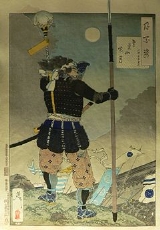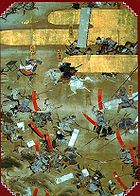
Yonekura Shigetsugu
Encyclopedia
YONEKURA Shigetsugu
Takeda retainer
d.1575
Tango no kami
Shigetsugu was a retainer of Takeda Shingen and served Amari Haruyoshi. He was killed at the Battle of Nagashino
.
During the Battle of Nagashino
1575) both Tokugawa
and Oda Nobunaga
sent troops to alleviate the siege and Takeda Katsuyori was defeated. The victory of Oda's Western-style tactics and firearms over Takeda's cavalry charge is often cited as a turning point in Japanese warfare; many cite it as the first 'modern' Japanese battle. Yonekura Shigetsugu was heroically killed in the fighting, following a suicidal individual charge by the Takeda flank, before being killed by gunfire, and later impaled on a pike by Nobunaga's forces. He was also notable for being in the battle of Kawanakajima.. (see Battles of Kawanakajima
)
Following the battle Nobunaga established effective control of Japan. Yonekura's death poem is often performed in Noh plays to this day, and is an example of Haiku
poetry for a death poem today. While death poems did not adopt any prescribed form as concerns syllabals, tone or length (the ritual required flexibility, in contrast to most Samurai rituals such as the Tea Ceremony
which were rigid), it was usually required to be short, pertinent and evoke pathos in the listener. It did not need to rhyme, just as Japanese singing was required to be dischordant and erratic. The flexibility of the death poem contrasts with the rigid caste
system that pervaded Japanese life.
Shigetsugu was part of the crucial Nagashino cavalry counter. In typical military strategy, the success of any cavalry charge depends on the infantry breaking ranks so that the cavalry can mow them down. If the infantry does not break, however, cavalry charges will often fail - with even trained warhorses refusing to advance into the solid ranks of opponents. By opposing this traditional charge the Takeda forces hoped to roll back the cavalry, much like traditional a Greek phalanx
, but failed.
His master, the late Amari Haruyoshi (also known as Amari Masatada) was a famous Takeda samurai. Believed to have been born 1533, Masatada was the eldest son of Amari Torayasu and served Takeda Shingen. He also fought at Kikyôgahara (1549), where the Ogasawara incurred a severe reversal at the Takeda's hands. He also served at the battles of 4th Kawanakajima (1561), Usuigatoge, and Matsuyama (1563). He was killed in a riding accident in 1564, when the horse trampled him as he was attempting to clot the bleeding from its Ilioinguinal nerve
. He is probably best known for an incident involving one of his wounded retainers. When the man's bleeding did not stop, Masatada advised him to drink horse feces and water to help clotting (a folk remedy). When the wounded man was hesitant to do so, Masatada himself consumed some of the concoction for him. Encouraged, his retainer drank from the same cup and reportedly recovered.


Takeda retainer
d.1575
Tango no kami
Shigetsugu was a retainer of Takeda Shingen and served Amari Haruyoshi. He was killed at the Battle of Nagashino
Battle of Nagashino
The ' took place in 1575 near Nagashino Castle on the plain of Shitaragahara in the Mikawa province of Japan. Forces under Takeda Katsuyori had besieged the castle since the 17th of June; Okudaira Sadamasa , a Tokugawa vassal, commanded the defending force...
.
During the Battle of Nagashino
Battle of Nagashino
The ' took place in 1575 near Nagashino Castle on the plain of Shitaragahara in the Mikawa province of Japan. Forces under Takeda Katsuyori had besieged the castle since the 17th of June; Okudaira Sadamasa , a Tokugawa vassal, commanded the defending force...
1575) both Tokugawa
Tokugawa clan
The was a powerful daimyo family of Japan. They nominally descended from Emperor Seiwa and were a branch of the Minamoto clan by the Nitta clan. However, the early history of this clan remains a mystery.-History:...
and Oda Nobunaga
Oda Nobunaga
was the initiator of the unification of Japan under the shogunate in the late 16th century, which ruled Japan until the Meiji Restoration in 1868. He was also a major daimyo during the Sengoku period of Japanese history. His opus was continued, completed and finalized by his successors Toyotomi...
sent troops to alleviate the siege and Takeda Katsuyori was defeated. The victory of Oda's Western-style tactics and firearms over Takeda's cavalry charge is often cited as a turning point in Japanese warfare; many cite it as the first 'modern' Japanese battle. Yonekura Shigetsugu was heroically killed in the fighting, following a suicidal individual charge by the Takeda flank, before being killed by gunfire, and later impaled on a pike by Nobunaga's forces. He was also notable for being in the battle of Kawanakajima.. (see Battles of Kawanakajima
Battles of Kawanakajima
The ' were fought in the Sengoku Period of Japan between Takeda Shingen of Kai Province and Uesugi Kenshin of Echigo Province in the plain of Kawanakajima, in the north of Shinano Province. The location is in the southern part of the present-day city of Nagano.The five major battles took place in...
)
Following the battle Nobunaga established effective control of Japan. Yonekura's death poem is often performed in Noh plays to this day, and is an example of Haiku
Haiku
' , plural haiku, is a very short form of Japanese poetry typically characterised by three qualities:* The essence of haiku is "cutting"...
poetry for a death poem today. While death poems did not adopt any prescribed form as concerns syllabals, tone or length (the ritual required flexibility, in contrast to most Samurai rituals such as the Tea Ceremony
Tea ceremony
A tea ceremony is a ritualised form of making tea. The term generally refers to either chayi Chinese tea ceremony, chado Japanese tea ceremony, tarye Korean tea ceremony. The Japanese tea ceremony is more well known, and was influenced by the Chinese tea ceremony during ancient and medieval times....
which were rigid), it was usually required to be short, pertinent and evoke pathos in the listener. It did not need to rhyme, just as Japanese singing was required to be dischordant and erratic. The flexibility of the death poem contrasts with the rigid caste
Caste
Caste is an elaborate and complex social system that combines elements of endogamy, occupation, culture, social class, tribal affiliation and political power. It should not be confused with race or social class, e.g. members of different castes in one society may belong to the same race, as in India...
system that pervaded Japanese life.
Shigetsugu was part of the crucial Nagashino cavalry counter. In typical military strategy, the success of any cavalry charge depends on the infantry breaking ranks so that the cavalry can mow them down. If the infantry does not break, however, cavalry charges will often fail - with even trained warhorses refusing to advance into the solid ranks of opponents. By opposing this traditional charge the Takeda forces hoped to roll back the cavalry, much like traditional a Greek phalanx
Phalanx formation
The phalanx is a rectangular mass military formation, usually composed entirely of heavy infantry armed with spears, pikes, sarissas, or similar weapons...
, but failed.
His master, the late Amari Haruyoshi (also known as Amari Masatada) was a famous Takeda samurai. Believed to have been born 1533, Masatada was the eldest son of Amari Torayasu and served Takeda Shingen. He also fought at Kikyôgahara (1549), where the Ogasawara incurred a severe reversal at the Takeda's hands. He also served at the battles of 4th Kawanakajima (1561), Usuigatoge, and Matsuyama (1563). He was killed in a riding accident in 1564, when the horse trampled him as he was attempting to clot the bleeding from its Ilioinguinal nerve
Ilioinguinal nerve
The ilioinguinal nerve is a branch of the first lumbar nerve . It separates from the first lumbar nerve along with the larger iliohypogastric nerve....
. He is probably best known for an incident involving one of his wounded retainers. When the man's bleeding did not stop, Masatada advised him to drink horse feces and water to help clotting (a folk remedy). When the wounded man was hesitant to do so, Masatada himself consumed some of the concoction for him. Encouraged, his retainer drank from the same cup and reportedly recovered.
Descendants
Muramatsu, Shigetsugu, co-inventor of semiconductor United States Patent 7180182 is descended from Yonekura Shigetsuga.. The Shigetsuga line also includes famed sword maker, KASAMA IKKANSAI SHIGETSUGU..
Attributed Quote (Noh play)
- like dew I was born
- like dew I die
- all life is but an illusion


